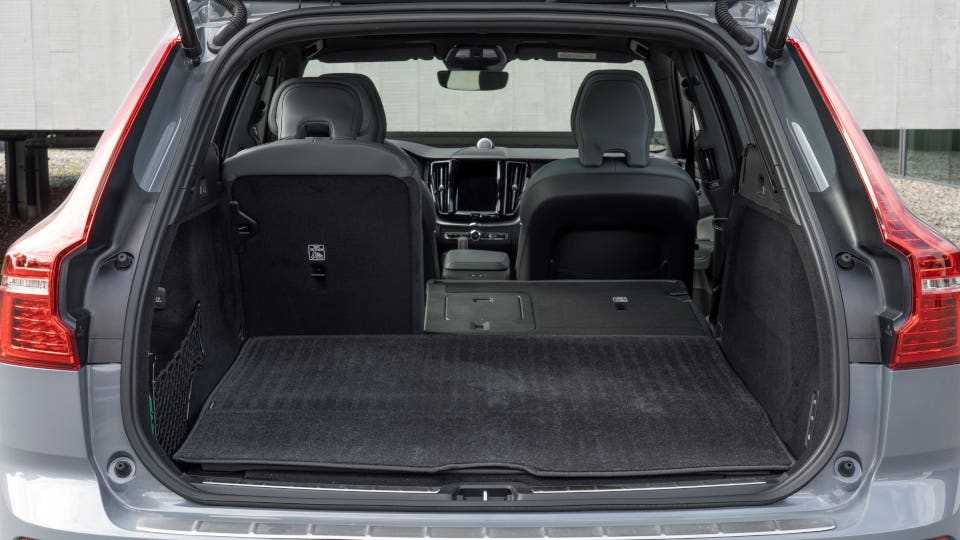Is the 2023 Volvo XC60 Worth It? Which Volvo XC60 Is the Best Value?
The base price for the Volvo XC60 Core B5 FWD is $45,840 (including destination). The AWD version is $48,140. XC60 Plus B5 FWD starts at $50,090, with AWD beginning at $52,390. XC60 Ultimate B5 FWD has a base price of $55,890. AWD begins at $58,190, and the XC60 Ultimate B6 (with an extra 48 horsepower and only available with AWD) starts at $63,740.
The plug-in hybrid XC60 Recharge lineup begins with the Core T8 at $59,590. The Plus T8 starts at $63,840. The Ultimate T8 base price is $69,340 and the Polestar Engineered T8’s base price is $76,540. All Recharge PHEVs are AWD.
Especially given the decent ground clearance, choosing an AWD XC60 makes sense. And while we may not be happy about paying for essential safety features like adaptive cruise control and lane-keeping assistance, we also wouldn’t go without them. That puts us in the XC60 Plus AWD model. (We’d be remiss if we didn’t mention that as good as the Harman Kardon premium audio system is, the $5,800 leap from Plus to Ultimate to get it, a head-up display and ventilated front seats flunks the value test).
That leaves the gasoline or PHEV decision. There’s an $11,450 price difference between the XC60 Plus B5 AWD and the XC60 Recharge Plus T8 eAWD. If your daily commute is less than 35 miles and you charge overnight, you can go months without using or buying gasoline. The fuel savings over the years would offset the price difference, and if the need for an impromptu road trip arrives, you won’t suffer range anxiety.
Safety & Driver Assistance Tech: 11/15
The Volvo XC60 gets a five-star overall crash rating from the National Highway Transportation Safety Administration (NHTSA), which ties the Lincoln Corsair, BMW X3 and Audi Q5 (the Lexus RX has not been tested for 2023 but received a four-star rating in 2022). Likewise, the Insurance Institute for Highway Safety gives the Volvo a good rating overall, but the Audi Q5 and BMW X3 both received a Top Safety Pick+, its highest rating. (The Lexus and Lincoln were both Top Safety Picks in 2022 but have not been tested for 2023).
Most of the essential active safety features are standard, but we’re disappointed that adaptive cruise control and lane-keeping assist require paying at least $4,250 for the mid-range Plus model. They are unavailable, even as a la carte options, in the Core model. And while it’s not essential, a head-up display is helpful and desirable, but to get that requires stepping up to the Ultimate model, which is $10,050 more than the Core.
 Rear seat legroom is slightly above average, but the seats themselves provide a near-ideal blend of comfort and support. Mike Hagerty
Rear seat legroom is slightly above average, but the seats themselves provide a near-ideal blend of comfort and support. Mike Hagerty
Технические характеристики
Для второго «релиза» вседорожника заявлено две бензиновые и две дизельные модификации, которые оснащаются исключительно 8-ступенчатым «автоматом» и полноприводной трансмиссией с многодисковой муфтой Haldex, отбирающей в зависимости от дорожных условий до 50% момента на колеса задней оси:
Дизельные версии имеют в подкапотном отсеке алюминиевую «четвёрку» объёмом 2.0 литра с рядным строением, интеллектуальным впрыском i-Art, турбонаддувом и ГРМ с 16-ю клапанами:
- D4 генерирует 190 лошадиных сил при 4250 об/минуту и 400 Нм вращающей тяги при 1750-2500 об/минуту;
- D5 «прячет» под капотом 235 «коней», которые «раскрываются» при 4000 об/минуту, обеспечивая 480 Нм предельной отдачи при 1750-2250 об/минуту.
Бензиновые исполнения 60-й модели XC-серии Volvo «вооружены» алюминиевым четырёхцилиндровым мотором на 2.0 литра с непосредственным впрыском, 16-клапанным ГРМ, настраиваемыми фазами распределения газов и турбонаддувом:
- T5 обеспечивает 254 «жеребца» при 5500 об/минуту и 350 Нм крутящего момента при 1500-4800 об/минуту;
- T6, благодаря сочетанию турбины с приводным компрессором, форсирован до 320 «лошадей» при 5700 об/минуту и 400 Нм при 2200-5400 об/минуту.
Гибридная модификация слегка отличается от «классических» машин:
- внешне – шильдиками на багажной двери и лючком для зарядки на переднем крыле с водительской стороны
- в салоне – главное отличие в том, что вместо тахометра тут индикатор состояния гибридной силовой установки
- конструктивно – в реализации полного привода (центральный тоннель, вместо карданного вала, содержит аккумуляторы, а заднюю ось крутит отдельный электродвигатель).
Под капотом T8-«гибрида» установлен 2.0-литровый бензиновый четырёхцилиндровый двигатель серии Drive-E с функцией непосредственного «питания», турбокомпрессором и приводным нагнетателем, вырабатывающий 320 «коней» и 400 Нм доступной тяги и вращающий передние колёса. Заднюю же ось приводит в движение 87-сильный электромотор который питает литий-ионная батарея способная обеспечить 10.4 кВт/час.
Суммарная отдача гибридной силовой установки составляет 407 лошадиных сил и 640 Нм момента, который подается на колеса посредством 8-ступенчатой АКПП с технологией электронного управления.
Гибридный привод автомобиля имеет пять алгоритмов работы:
- Hybrid – автоматический режим, где всё определяет электроника;
- Pure Electric – в данном случае задействована исключительно электротяга («дальнобойность» в таком режиме ≈40 км);
- Power Mode – здесь используются весь потенциал обоих двигателей одновременно;
- AWD – постоянный привод на все колёса;
- Save – в этом режиме «замораживается» литий-ионный аккумулятор с целью экономии энергии.
Конструктивные особенности
Этот автомобиль базируется на укороченной платформе SPA (Scalable Product Architecture) с расположенным поперечно силовым агрегатом и структурой кузова, в которой широко использованы высокопрочные и сверхвысокопрочные стали.
Базовая подвеска – пружинная «двухрычажка» на передней и «многорычажка» с поперечной композитной рессорой на задней оси. Но за доплату для этого SUV предусмотрены пневматическое шасси и адаптивные амортизаторы.
Вне зависимости от версии, «швед» комплектуется реечным рулевым комплексом и электрогидравлическим усилителем с настраиваемыми характеристиками. На всех колёсах вседорожника задействованы вентилируемые «блины» тормозной системы, работающие вскладчину с ABS, EBD и другими электронными помощниками.
Infotainment: 11/15
The standard infotainment system in the 2023 Volvo XC60 is a ten-speaker Bower & Wilkins system that offers above-average sound reproduction. Bluetooth, four USB ports, a Wi-Fi hotspot, wireless charging and wireless Apple CarPlay and Android Auto are standard equipment.
Also standard is a portrait-oriented nine-inch touchscreen. It’s a great size, but too many vehicle functions are buried in it. Seeing them all requires swiping across three screens. Even the owner’s manual is buried in there, meaning to look up how to use the screen—you have to use the screen. Navigation now comes via Volvo’s Android-based infotainment interface, which will instantly look familiar to Android phone users but takes some getting used to for anyone else.
Unlocking the excellent 15-speaker Bowers & Wilkins sound system requires moving all the way up to the Ultimate model at a premium of $10,050.
 A 60/40 folding rear seat back helps make the most out of the XC90’s cargo area. From this angle, it reminds us of the Volvo wagons that helped the brand make its mark in the U.S. decades ago. Mike Hagerty
A 60/40 folding rear seat back helps make the most out of the XC90’s cargo area. From this angle, it reminds us of the Volvo wagons that helped the brand make its mark in the U.S. decades ago. Mike Hagerty
Performance: 14/15
Even with the next-to-lowest base horsepower in the competitive set, the XC60 is a comparatively quick machine. The 247-horsepower B5 engine’s zero-60 time of 6.5 seconds ties the Lincoln Corsair (which has 22 more ponies) and blows past the Lexus RX 350 (7.6 seconds); only the 2023 BMW X30i can edge it out at 6.0 seconds flat. The B6 engine (available only in Ultimate AWD) brings 295 horsepower and cuts the time to 60 to 5.9 seconds. The Lexus RX 500h F SPORT Performance AWD can tie that, but that vehicle starts at close to $63,000—almost $18,000 above the base price of the XC60 Core B5 FWD.
The Recharge PHEV’s T8 powerplant dials up the horsepower to 455, and the zero-60 time is just 4.5 seconds. Keeping the comparison strictly between PHEVs, the Lincoln Corsair Grand Touring PHEV AWD only produces 266 horsepower, and its 0-60 time is seven seconds flat—slower than its base engine. Audi Q5 PHEV is quoted at 5.0 seconds. (Manufacturer-supplied stats, real world-estimates will vary.)
XC60 Core, Plus and Ultimate with the base B5 powertrain can be had in either FWD or AWD. The Ultimate B6 and all T8 Recharge PHEVs are AWD only. It boasts 8.3 inches of ground clearance—the most of the competitive set— so light off-roading is definitely on the table. In addition, the XC60 is rated to tow 3500 pounds in all configurations.
Fuel Economy: 14/15
The Volvo has the highest average combined fuel economy at 25 miles per gallon among gasoline and mild-hybrid models. Specifically, the B5 front-wheel drive is EPA-rated at 26 mpg combined, 23 city and 30 highway. (AWD subtracts one mpg in combined and highway.) The B6 AWD powertrain returns 23, 21 and 27 mpg in the same metrics. The Lexus and Lincoln return 24 mpg combined; for an outside comparison, consider the Cadillac XT5 V6 delivers 22 mpg.
The XC60 T8 Recharge PHEV is EPA rated for 63 MPGe (miles per gallon equivalent) and has an electric-only range of 36 miles. The Lincoln Corsair Grand Touring PHEV AWD—which has 189 fewer horsepower than the Volvo XC60 Recharge—is rated at 78 MPGe and has an electric-only range of 28 miles. The Audi Q5 PHEV is rated for 61 MPGe, but its electric-only range is just 23 miles.
Operating in pure hybrid mode (without the benefit of a fully charged battery), the Volvo XC60 Recharge returns 25 mpg, the Lincoln 33 mpg and the Audi 26 mpg.





























